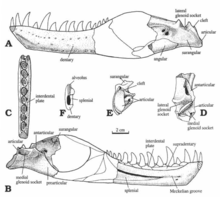Bagaraatan
| Bagaraatan | |
|---|---|

| |
| Lower jaw bones | |
| Scientific classification | |
| Domain: | Eukaryota |
| Kingdom: | Animalia |
| Phylum: | Chordata |
| Clade: | Dinosauria |
| Clade: | Saurischia |
| Clade: | Theropoda |
| Clade: | † Pantyrannosauria
|
| Genus: | †Bagaraatan Osmólska, 1996 |
| Type species | |
| †Bagaraatan ostromi Osmólska, 1996
| |
Bagaraatan (/'ba-ɣa-raa-tan/ meaning 'small' baɣa + 'carnivorous animal, beast of prey' araatan in Mongolian) is a
History

The type species, B. ostromi, was described by Halszka Osmólska in 1996. Initially, the post-cranial (ZPAL MgD-I/108) skeleton had been described as "bird-like", while the skull was noted to exhibit features of several different theropod groups.
The material that warranted this conclusion was later found to be a chimaera of two non-avian dinosaurs, with some of the post-crania (hand bones, left femur, tibiotarsus, and rib) being referred to an indeterminate
Classification

Below is the cladogram by Loewen et al. in 2013.[3]
| Tyrannosauroidea |
| ||||||||||||||||||||||||||||||||||||||||||||||||||||||||||||
In their 2024 reassessment of Bagaraatan, Słowiak,
References
Sources
- Osmolska, H. (1996). "An unusual theropod dinosaur from the Late Cretaceous Nemegt Formation of Mongolia". Acta Palaeontologica Polonica 41; 1-38 [1]
External links
- Dinosaur Mailing List entry which discusses the genus Archived 2012-02-04 at the Wayback Machine
![]() Media related to Bagaraatan at Wikimedia Commons
Media related to Bagaraatan at Wikimedia Commons
![]() Data related to Bagaraatan at Wikispecies
Data related to Bagaraatan at Wikispecies

